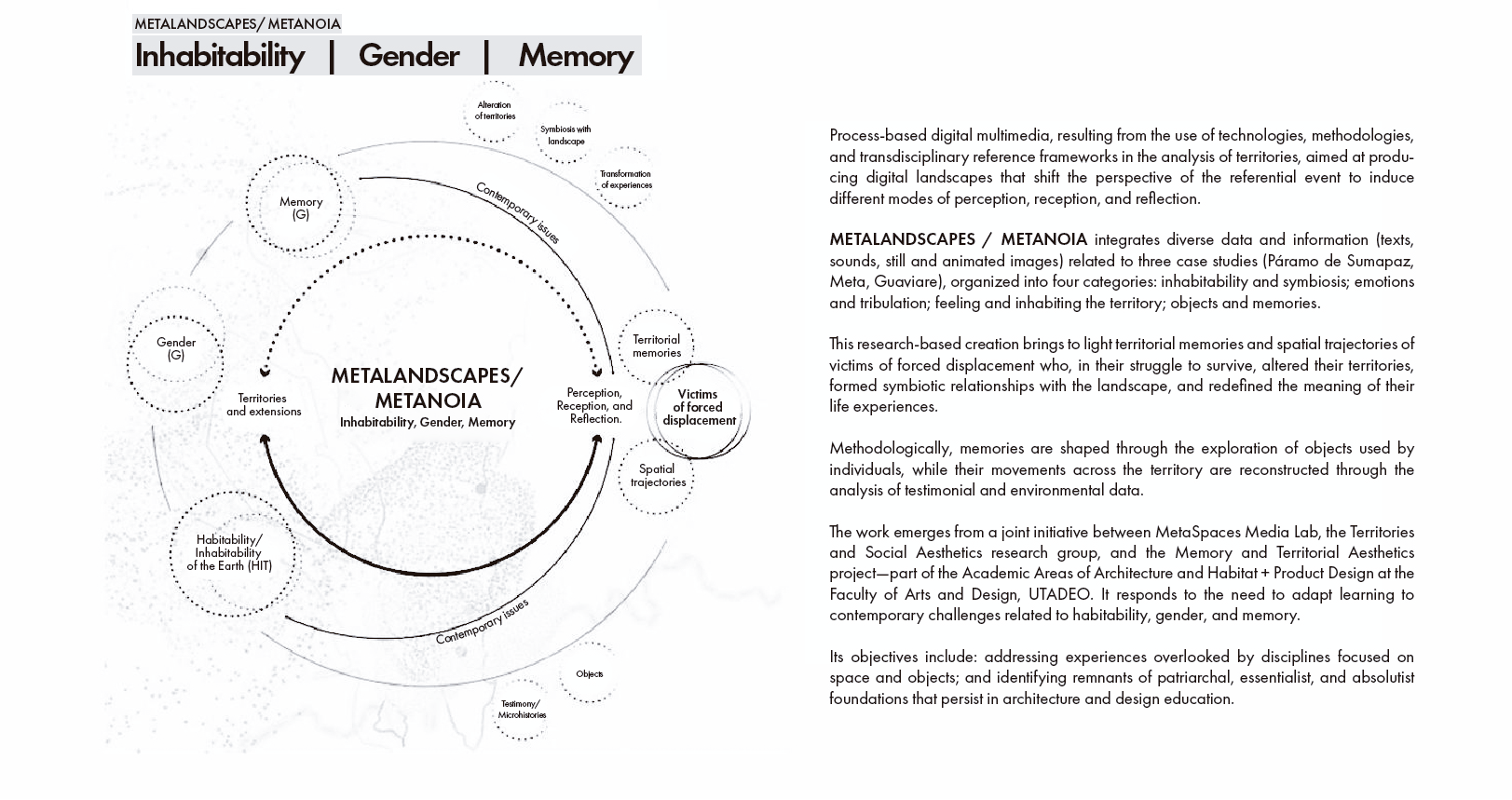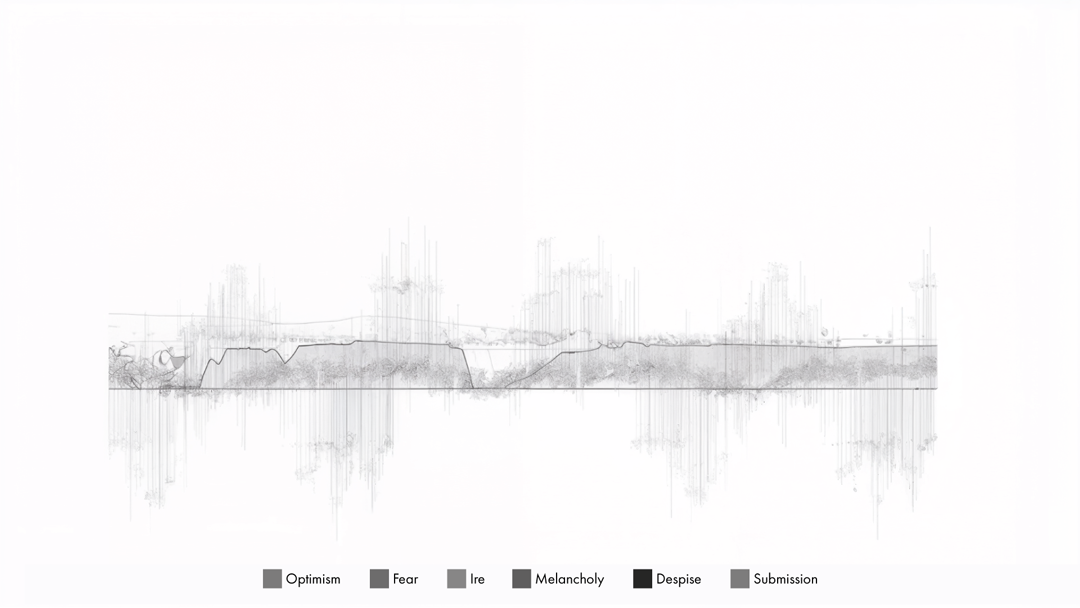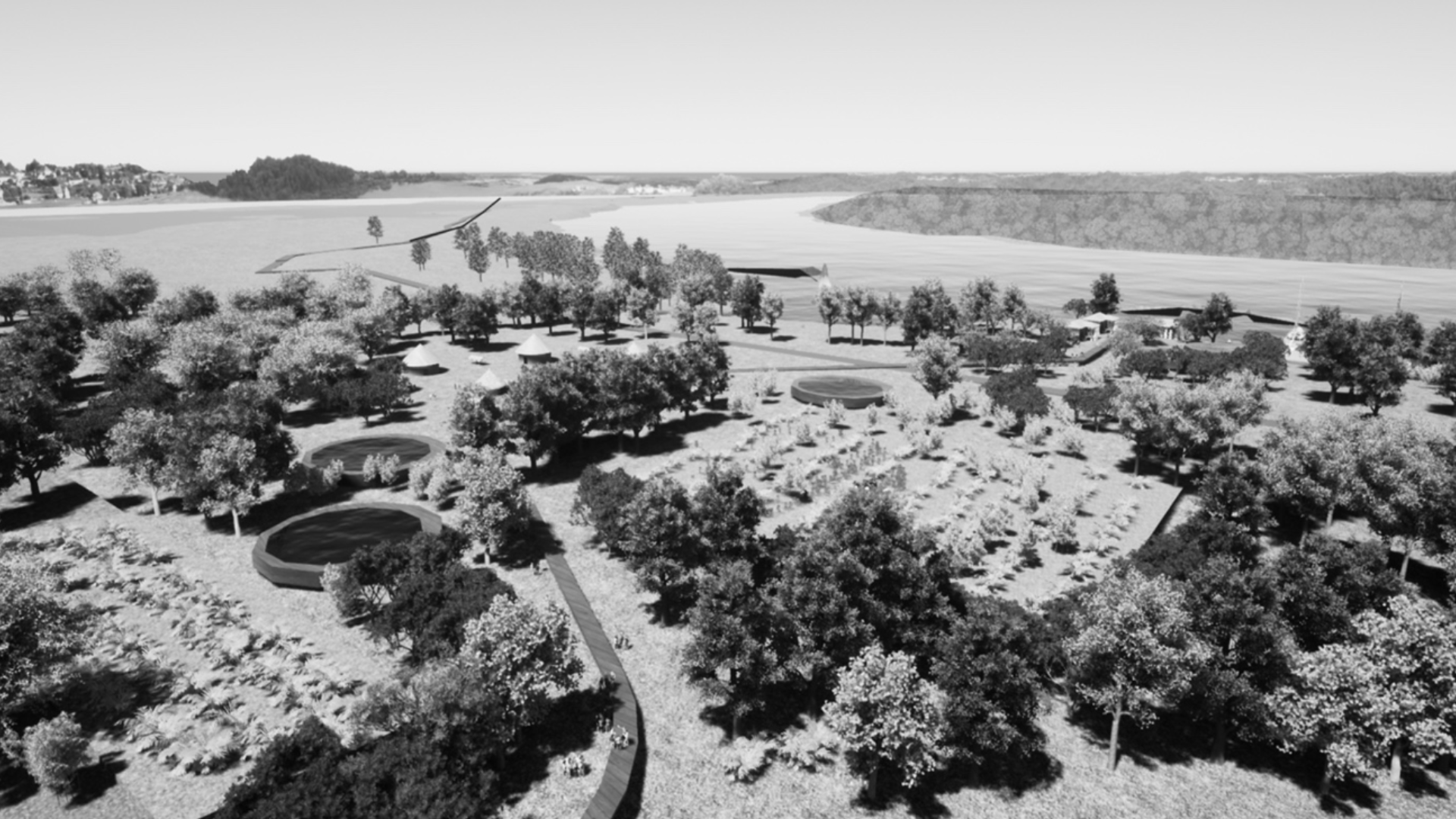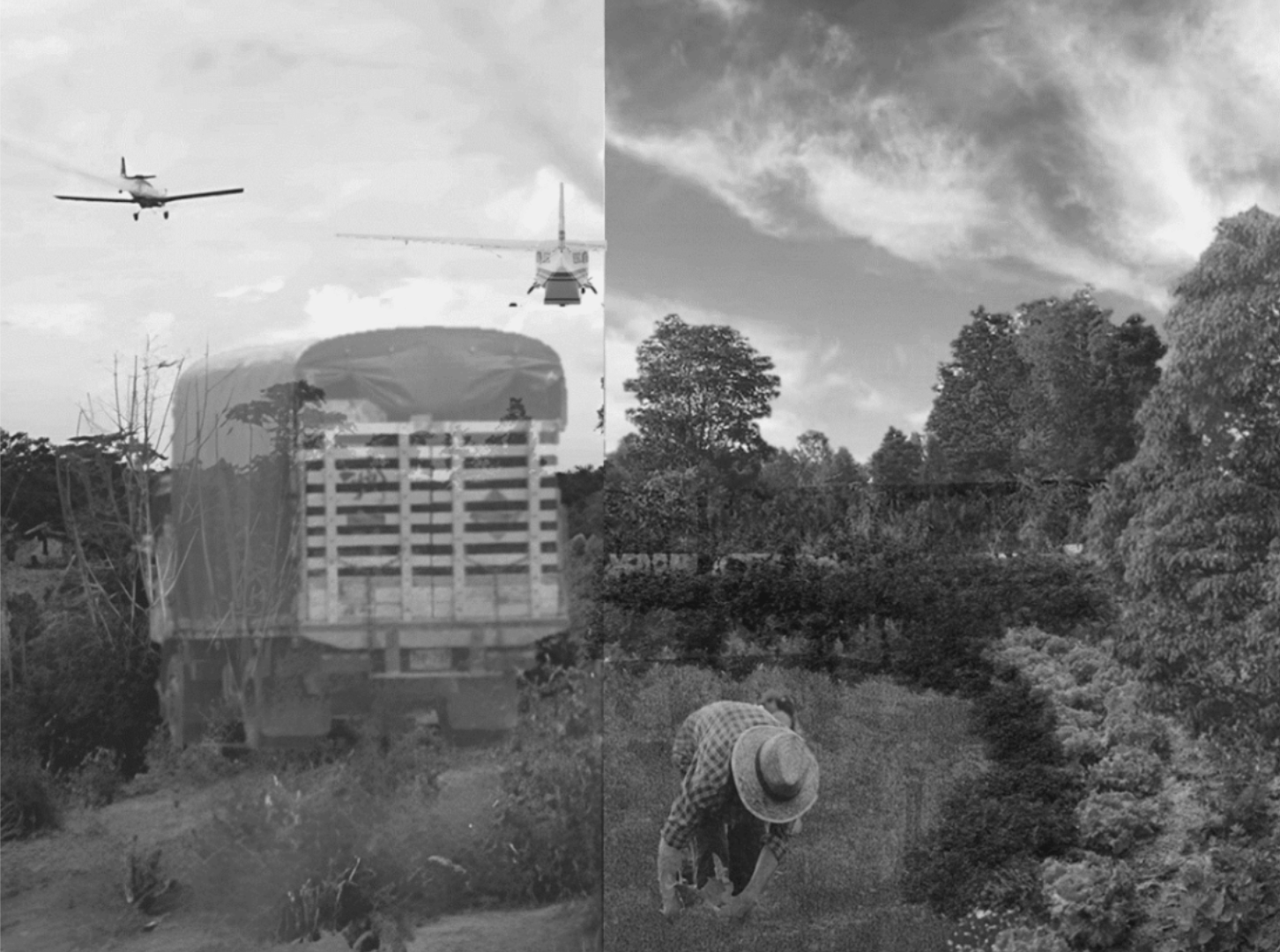
How to Cite: Gómez Granda, Pablo Andrés and Sebastián Camilo Nova Olivos. "Hybrid Landscapes, Memory, and Metanoia in Colombia's Armed Conflict". Dearq no. 42 (2025): 66-74. DOI: https://doi.org/10.18389/dearq42.2025.07

How to Cite: Gómez Granda, Pablo Andrés and Sebastián Camilo Nova Olivos. "Hybrid Landscapes, Memory, and Metanoia in Colombia's Armed Conflict". Dearq no. 42 (2025): 66-74. DOI: https://doi.org/10.18389/dearq42.2025.07
Pablo Andrés Gómez Granda
Universidad de Bogotá Jorge Tadeo Lozano, Colombia
Sebastián Camilo Nova Olivos
sebastianc.novac@utadeo.edu.co
Universidad de Bogotá Jorge Tadeo Lozano, Colombia
Received: January 31, 2024 | Accepted: January 19, 2025
This article explores hybrid landscapes as a form of memory production related to the armed conflict in Colombia, influencing how events are perceived and fostering shifts in perspective regarding both the facts and the territories in which they occurred. The argument draws on theoretical developments concerning landscape, perspective shifts, and memory, which not only contribute to the development of a research-creation process but also support a discussion on the notions of idea and concept. The article concludes with a reflection on sensitivity to ideas as a potential contribution of architecture to the processes of making the conflict more visible.
Keywords: Conflict, inhabiting, ideas, memory, model, landscape, territory.
This article seeks to foster reflection on the armed conflict in Colombia by exploring the impact of hybrid landscapes on people's sensitivity and understanding. The study area, selected to examine the effects of the conflict on both the territory and its communities, is defined by a rational criterion—the volume of information contained in the 2022 Final Report of the Colombian Truth Commission. This area includes parts of the Meta and Guaviare departments, as well as the Sumapaz region. However, its boundaries were also shaped by an emotional dimension.
Sumapaz, both as a locality and a paramo ecosystem, is an essential part of Bogotá. Its significance captured the attention of a group of architecture students and professors who, after visiting the Huellas de la Desaparición exhibition at the Miguel Urrutia Museum of Art (MAMU) in Bogotá in 2022, were inspired to engage with a research group in Product Design. Led by Professor Diana Castelblanco, this group had been exploring themes of memory. The exhibition, documented by the Truth Commission and produced by Forensic Architecture, employed scenographic installations and data visualization technologies to bring narratives of Colombia's armed conflict into focus. It provided an opportunity to reflect on space as a subject of architectural study in relation to the country's realities. This experience, in Deleuze's terms (2012, 31), constituted an event—one that did not merely reproduce any prior experience for the participants but stood apart from the imaginary dispersion through which the world dissolves the coherence of thought, "or what Mallarmé called those misty places where all reality dissolves"1 (Badiou 2017, 21).
The event evoked "a lasting astonishment, akin to what Kant calls admiration—one that does not fade after the first experience" (Huyghe 2022, 103), a "contingency that could not be absorbed and exceeded all expectations" (Hui 2022, 58), to the extent that it led the group to develop a macro research-creation project. This project integrates, supports, and guides research initiatives by architecture and design students. The visit to the exhibition coincided with one student's journey to the Güejar Canyon, where a community of former FARC combatants had launched a tourism initiative as part of Colombia's peace process and various government-led efforts to promote justice and strengthen communities and territories affected by the conflict. The Güejar Canyon became an experience in which rational data and political ideas of the community converged with the sensory richness of nature's forms and colors, offering a profound insight: unveiling a territory can influence "the existing configuration of established modes of perception and objects of thought" (Rancière 2020, 9). As a result, the student and the entire group decided to investigate the consequences of the armed conflict on the territory and its communities—an approach that introduces a new architectural subject of thought and a transformed perception of space.

Figure 1_ Metalandscapes / Metanoia. QR access to digital process-based work. Source: Pablo Gómez.
Metalandscapes / Metanoia: Inhabitability, Gender, Memory is a process-based digital multimedia project based on the use of technologies, methodologies, and transdisciplinary frameworks in territorial analysis. It is intended to generate digital landscapes that shift the perspective of referential events, inducing different modes of perception, reception, and reflection. This work originates from the A.I. Media Lab and the Territories and Social Aesthetics research group, part of the Architecture and Habitat + Product Design academic areas in the School of Arts and Design at Universidad de Bogotá Jorge Tadeo Lozano. It responds to the need to adapt architectural and design education to contemporary challenges related to habitability, gender, and memory. Despite significant advancements in various parts of the world, scientific literature on architecture and design still lacks exemplary cases that address memory and armed conflict. This gap persists even as universities increasingly offer courses exploring the intersections of architecture, human rights, and memory (Buzaglo 2018). As a result, the foundational source for the research behind this creation was the Final Report of the Truth Commission.
Methodologically, the research-creation process is structured around three interrelated axes that operate simultaneously rather than as sequential stages: inquiry and reconstruction of memories, memory visualization through digital technologies, and the establishment of conceptual frameworks. Memories are shaped through the exploration of objects used by individuals, while their movements across the territory are reconstructed through the analysis of testimonial and environmental data. From a technological standpoint, memory visualization is achieved through digital modeling and simulation, supported by geolocation, animation, and artificial intelligence. Conceptually, the theoretical framework and state of the art guide the visibility of experiences overlooked by disciplines focused on space and objects. They propose a discussion on the notions of "idea" and "concept" in architecture.

Figure 2_ Metalandscapes / Metanoia. Schematic overview of digital process-based work. Source: María Paula Orjuela.
The digital environment of this work integrates various data and media types—texts, sounds, still and animated images—related to three case studies: Paramo de Sumapaz, Meta, and Guaviare. Each case corresponds to a research-creation project that explores themes such as inhabitability and symbiosis, tribulation and emotion, sensitivity and habitability, and memory and objects. These projects form hybrid landscapes, digital reconstructions of physical landscapes shaped by the specific challenges of each case study. The work is designed as an evolving platform, allowing for the continuous addition of new data, research outputs, and case studies, reinforcing its process-based nature and multidimensional perspective.

Figure 3_ Inhabitability and Metanoia. A rendered image of forced displacement. Source: María Paula Orjuela.
Architect María Paula Orjuela's project, Inhabitability and Metanoia. Symbiosis and Drift in the Territory of Sumapaz, maps and analyzes the spatiotemporal trajectories of forced displacement experienced by a woman affected by the armed conflict in the 1980s. Using digital spatial mapping tools and computational modeling, the project reconstructs these movements to deepen the understanding of displacement dynamics. Paths of Peace in Sumapaz, a project by designer Karla Moreno, explores memory through objects that mutate, amplifying narratives of displacement and transformation. In Meta, architecture student Daniela González is developing Emotions and Tribulation: Metamorphosis in the Constructive Act of Memory. Using mental imagery technologies, her project maps and visualizes brain activity triggered by emotional responses to the experiences of conflict victims during the final decade of the 20th century.

Figure 4_ Emotions and Tribulation. Soundscape diagram. Source: Daniela González.
Finally, Sebastián Nova's project Feeling and Inhabiting the Territory: Synergy Between Appropriation and Evolution based on Guaviare, intersects with The Rite and the Jiw, led by product design student Sofía Fonseca. This project emphasizes the role of plants as carriers of memory and narrators of the territory's history, preserving the experiences of its Indigenous inhabitants. Since the Jiw community extends into Meta, the project spans both Guaviare and that region, linking the territories through cultural and ecological narratives.
Meta and Guaviare have been epicenters of mass forced displacement due to their strategic location, making them highly contested territories for various actors in the armed conflict. Both the communities and landscapes have suffered deep physical and psychological violence, leaving enduring scars (Truth Commission 2022). The Jiw Indigenous people, who inhabit the Barrancón reserve along the banks of the Guaviare River, have built their life stories by overcoming the impacts of violence. Their deeply rooted memory, akin to a secure attachment (Cyrulnik 2015), has historically fostered their resilience, strengthened by their awareness of the territory and vegetation as symbols of life (Ruiz and Ojeda 2023) and as nonhuman living beings. This strength is closely tied to their profound connection with the land and vegetation—not only as symbols of life (Ruiz and Ojeda 2023) but as sentient, nonhuman beings, integral to their cultural and spiritual world (Coccia 2017).

Figure 5_ Photomontage of the territory in the past. Source: Sebastián Nova.
The Feeling and Inhabiting project proposed a physical journey with stations equipped with digital models that, when accessed via QR codes, convey lived experiences of the conflict, integrating them into the country's historical narrative. These digital models function as more than mere narrative devices (Agamben 2014); they become expressive apparatuses (Huyghe 2014), forming a synergy of stories, anecdotes, and emotions that visualize memories of the armed conflict. These apparatuses serve as an attempt to visually articulate the unvoiced (Rancière 2009), often excluded from official linguistic discourses. Their expressive and semantic traits, rather than being abnormal, are anomalous (Canguilhem 2005), rendering them irreducible to normative languages.
The research-creation project explores the concepts of "feeling" and "inhabiting." "Feeling" refers to the emergence of emotion as a result of physical sensation or mental states (Simondon 2012). The act of "inhabiting" involves transforming a place into a meaningful space, in which an individual establishes an emotional bond with their surroundings (Saldarriaga 2016). The project is structured into four methodological phases. It begins with a mental map of the territory based on three coordinates: the Jiw community, the community's sense of value for the territory, and local narratives along with their historical background. Next, a state-of-the-art review and theoretical framework are developed, which, in addition to enriching the ideas of memory and territory, set the stage for the discussion at the end of the article. Following this, a digital model is created to reconstruct the territory and design the physical landscape intervention project. Finally, the fourth phase addresses possible displacements and resignifications of meaning in a territory fractured by violence, drawing on the community's historical bond with the land, as transmitted through oral narratives (Centro Nacional de Memoria Histórica 2023).

Figure 6_ Mapa mental. Source: Sebastián Nova.
The mental map, based on data from the Truth Commission Report, identifies five key themes—causes, effects, information technologies, involved actors, and solutions—that form a complex web of interconnected factors. These dynamics are shaped by struggles for territorial control and the resulting deterioration in the region and its communities. The second phase introduces the concepts of territory and rhizome (Deleuze and Guattari 1980), proposing that geographical space is decentralized and shaped by continuous interactions between fauna, flora, people, and armed conflict. Actor-network theory (Latour 1992) is also considered; it challenges the traditional human/nonhuman divide and recognizes the agency of nonhuman entities, objects, and technologies in shaping reality. The book Belicopedia (Ruiz and Ojeda 2023) provides insights into warfare scenarios in which nonhuman entities play active roles, while relational ecosophy (Guattari 1989) expands the concept of ecology to include elements such as mental health and social life.
In the third phase, the digital model—developed using cartographic data from the Instituto Geográfico Agustín Codazzi and topographical mapping of the Barrancón territory created with the CadMapper application—highlights four key elements affected by the conflict, each with a direct impact on the Jiw community: the river, glyphosate, vegetation, and the land. Each of these elements has suffered significant damage, and in response, the project aims to transform them positively by visualizing their evolution through photomontages that contrast present conditions with a projected future. The Guaviare River is depicted in its current state, bearing the scars of decades of violence, pollution from toxic waste, and environmental degradation. The forward-looking approach centers on revitalizing activities such as fishing to restore the river as a source of sustenance for the community and to renew its connection to the water—imbued with the meaning of élan vital (Bergson 1963). Beyond supporting daily life, this renewed relationship with the river offers an opportunity to foster awareness that ecosystems, rather than simply deteriorating, can evolve creatively (Bergson 1963) or, in more contemporary terms, regenerate.

Figure 7_ Rendered image of the proposed route. Source: Sebastián Nova.
Addressing the environmental ecosystem and the disruption of its balance caused by glyphosate—which affects not only illicit crops but all plant species and wildlife—the project advocates for sustainable agricultural practices and the restoration of degraded habitats. Among these efforts, the recovery of certain medicinal herbs is particularly significant, as their revitalization offers both a physical and symbolic resource for the well-being of local communities. This initiative fosters stronger connections between communities and nature, aligning with the concept of "epistemologies of the heart" (López Intzín 2010). The project also intended to restore habitats and traditional cultures rooted in ancestral knowledge (Consejo Regional Indígena del Cauca 2021), contributing to the creation of a setting in which communities can cultivate deeper ties with the historical temporalities of their territory—foundations that may shape sustainable ways of inhabiting the present and the future.
The project, at its core, aims to redefine and reimagine the territory. The digital model visualizes these transformations through a pathway that guides visitors through modified landscapes, allowing them to experience the scale of change firsthand and reflect on its impact on the environment and local communities. Reframing the territory provides communities with a space that encourages interaction and strengthens their connection to the past. It becomes a living archive in which stories and memories of the conflict are preserved, transforming historical narratives into meaningful learning experiences.

Figure 8_ Photomontage: Past and Perspective. Source: Sebastián Nova.
As hybrid landscapes form the core of the Metalandscapes/Metanoia project, reflection on the notion of landscape itself became essential, leading to arguments about the potential reinterpretation of historical events by those engaging with these hybrid landscapes. It raised critical questions about the concept of "concept" in architecture. Although reflections on landscape emerged before the work of Immanuel Kant, the history of ideas in the Western world favored the definition established by the German philosopher. To understand his perspective on landscape, we first need to recall his views on architecture. Architectural forms are defined by two fundamental characteristics: they respond to the architect's intent and serve a specific purpose.
This is why Kant considers them "arbitrary" (Kant 1992). The first characteristic implies that, unlike the forms found in painting and what Kant's era referred to as the liberal arts, architecture does not imitate nature, which is therefore not its natural model (Batteux 1746). The second suggests that the very idea of architectural design presupposes that a building's intended use—its predetermined purpose in conception and thus a priori to its a posteriori execution—requires a relationship of coherence between the built structure and its original concept or design seed. One of Kant's most enduring contributions to architectural thought is the idea that architecture surpasses the other so-called mechanical arts in terms of perfection, as its concept can be precisely realized or executed. The history of landscape, by contrast, does not share this same aura of "perfection" (Rancière 2023, 21).
The inclusion of the idea of landscape—and its associated practices—within the domain of the liberal arts takes on particular significance, especially when contrasted with the inherited notion of architectural perfection. This perspective is essential for understanding hybrid landscapes, as—even though a constructed physical landscape can be traversed by a potential user (unlike painting, the quintessential liberal art)—it remains, like all liberal arts, an art of appearance. Liberal art produces the appearance of architectural spatial construction, which follows a determined purpose with the intent of "eliciting a specific pleasure" (Rancière 2020, 21). This specific pleasure is none other than that which arises from the "free play of the imagination in the contemplation of forms" (Kant 1979, 151). This free play is particularly relevant to the Feeling and Inhabiting the Territory project, as it aims to heighten the user's sensitivity to ideas within these hybrid landscapes, in which the physical and digital interact. In this context, ideas should not be understood as a generative form or a "shaper of materials" (Hustvedt 2022, 171). Rather, sensitivity to ideas refers to metanoia (Huyghe 2024)—a shift in perspective on a historical event that a hybrid landscape can evoke.
A concept, by contrast, does not prompt a shift in perspective regarding external events such as history, given its inherently categorizing nature. Just as post-Romantic Germany witnessed a revolution in subjectivity—in which individuals were endowed with internal faculties no longer dependent on adaptation to external circumstances, a transformation that defines the contemporary subject (Castro-Gómez 2022)—architecture developed its own internal laws, independent of its relationship to landscape as an externality.
In the construction of these internal laws, a sovereign was required—one whose defining demand was to be causa sui: the concept, an absolute force that neutralizes any form of otherness challenging its freedom and expansive power. The concept's capacity to unify multiplicity and sensory experience in architecture also inherits another key trait from the post-Romantic revolution in subjectivity: self-awareness (Wulf 2022). To actualize itself, this self-awareness must overcome the obstacles posed by the earth, matter, memory, imagination, chaotic emotions, and intuitions—or, simply, sensitivity to ideas.
The very fact that we can conceive of ideas such as repair, memory, or anything that exceeds the limits of understanding—a landscape created for the occasion—implies a certain freedom from historical and factual reality. In the works described, this manifests as freedom from what has already been. The political and ethical consequence of such creations is that they make individuals increasingly receptive to ideas. While an idea does not arise from direct experience, cultivating sensitivity to ideas—independent of historical facts—means nurturing a vision of what could be, if not what should be. This includes utopias, future scenarios, speculative designs, and architectural or urban projects.
In sum, shifting perspectives on an event—introducing new modes of perception and reception of referential facts—constitutes, in Kantian terms, the capacity to reason about an event from a different standpoint. It implies an act of freedom in relation to historical and factual reality. This process is no longer categorical or conceptual, as it does not aim to synthesize historical reality but rather to open it up to new possibilities. Thus, knowledge of the history of Colombia's armed conflict acquires new interpretative and expressive dimensions. The research-creation process described here has, among other contributions, laid the groundwork for a new study on how the armed conflict affects both human and nonhuman perception of habitat and chromatic spectra. As noted in the introduction, this involves a new way of perceiving space, offering insights for both habitat construction and the development of new forms of architectural knowledge—knowledge that is likewise hybrid and heterogeneous, characterized "by differences in nature rather than differences in degree" (Hui 2022, 370).
1 Unless otherwise specified, all citations in this article have been translated by the article's translator.